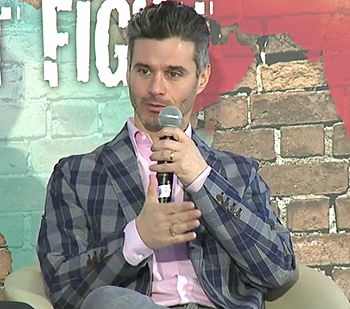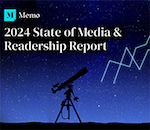The "millennial" demographic coveted by marketers and advertisers is a consumer force that will trump the Baby Boomers, but targeting the generation born since the early 1980s requires a deft, engaging and authentic approach, Evan Shapiro, president of the cable network Pivot, told Gibbs & Soell's annual conference in New York this month.
Shapiro, former president of IFC TV and Sundance Channel, leads a year-old network owned by Participant Media that specializes in reaching the millennial segment, often with content – entertainment and advertising -- that is influenced or generated from its target audience.
 |
Asked by an audience member at the "Global Street Fight" event April 11 how marketers can get around complaints from millennials that companies are pandering to them, Shapiro replied with step one: "Get rid of the 'millennial' term. It sounds like marketing. Call them Generation Y."
Pivot, which has a significant web presence and is in more than 45M households, affiliates with educational non-profits and has 15 studios on college campuses across the country. When an advertiser like Hyundai, for example, wants to commission content for Pivot from that college network, it issues an RFP through Pivot, which believes the content or advertising (or mix of both) produced fosters deeper ties to viewers because it is sourced through them.
Shapiro said that Comedy Central's Adult Swim is the top network for Gen Y, noting that ads on that network look like content from Adult Swim, itself. "The Super Bowl kept people watching through a bad game because those ads are just good content," he said of Seattle's February rout of the Denver Broncos.
Whole Foods Market in January partnered with Pivot to produce a TV series, "Dark Rye," highlighting recipes, health issues and related content inspired by the retailer's online magazine of that name.
Shapiro said the younger generation favors a type of altruism over unabashed capitalism and wants to know where companies stand. He noted 90% of Gen Yers like when a brand talks about what they do, and 80% say they would take less money to work for a responsible company. "You have to think about how your brand affects the world," he said. "This generation is going to hold you to it. Nobody is perfect but we all do have to leave the place better or our brands will be punished." But that desire for responsibility in companies should not be confused with purity. He added: "They buy junk food. They buy soda. They're not saints."
The generation's desire for more from the brands they use also applies to the medium of TV itself.
TV Still Most Effective
Television remains the "most powerful medium on earth," but it "has gone from mass media to niche media," said Shapiro. He noted a hit show like "All in the Family" used to garner an audience north of 67M, while today Jimmy Fallon's "Tonight Show" is a success at around 3.3M viewers per night and "The Colbert Report" is lauded at one million viewers. "Mad Men" is culturally powerful and widely acclaimed, yet its premier this month logged 2.3M viewers. While the relatively smaller figures provide more segmentation for marketers, the method of reach has changed as well. "It's not pure reach anymore," he said. "It's about brand engagement and intent to use [a product or service]. They expect more from TV and wants brands to stand for something."
Robert Fronk, executive VP of corporate image and strategy at Nielsen, in revealing the latest results of Gibbs & Soell's "Global Street Fight" study April 11, said that Gen Y brings an impatience and expectation of inclusion to its view of corporate leadership. "[Gen Yers] want to become leaders more quickly, but see leadership as collective with a strong natural consensus … No one is looking for companies to fix the world's problems as their corporate purpose."
Pivot sees engaging the audience in the content production process is key to that company/brand connection and "open-source" content is the means to that end. "For and by Generation Y is a big deal to them," said Shapiro. "A lot of our decisions involve their feedback."
Shapiro, however, stressed the difference between user-generated and open-sourced content. User-generated content is "cats on trampolines," he said, while open-source still allows for chief decision makers while incorporating ideas of the collective. Where UG content is chaos, OS is collaborative.
He added: "Gen Y doesn't necessary need to make decisions, but they want to be involved in the process."


 Trump Media & Technology Group today reported a $58.2M net loss on $4.1M in 2023 revenues, a disclosure that drove its stock price down 22.6 percent to $47.96.
Trump Media & Technology Group today reported a $58.2M net loss on $4.1M in 2023 revenues, a disclosure that drove its stock price down 22.6 percent to $47.96. Barry Pollack, an attorney at Wall Street’s Harris St. Laurent & Wechsler, has registered Julian Assange as a client with the Justice Dept. “out of an abundance of caution.”
Barry Pollack, an attorney at Wall Street’s Harris St. Laurent & Wechsler, has registered Julian Assange as a client with the Justice Dept. “out of an abundance of caution.” Paramount Global to slash 800 jobs in what chief executive Bob Bakish calls part of an effort to “return the company to earnings growth"... Rolling Stone editor-in-chief Noah Shachtman is exiting at the end of the month due to disagreements with chief executive Gus Wenner over the direction the magazine is taking... The New York Times broke the $1 billion barrier in annual revenue from digital subscriptions in 2023... Press Forward is investing more than $500 million to strengthen local newsrooms.
Paramount Global to slash 800 jobs in what chief executive Bob Bakish calls part of an effort to “return the company to earnings growth"... Rolling Stone editor-in-chief Noah Shachtman is exiting at the end of the month due to disagreements with chief executive Gus Wenner over the direction the magazine is taking... The New York Times broke the $1 billion barrier in annual revenue from digital subscriptions in 2023... Press Forward is investing more than $500 million to strengthen local newsrooms. The majority of news articles are read within the first three days of publication, according to a recent report.
The majority of news articles are read within the first three days of publication, according to a recent report. The Los Angeles Times gives pink slips to 115 people or 20 percent of its newsroom staff... TIME is also laying off about 30 employees, which is approximately 15 percent of its editorial staff... The Baltimore Banner, which was launched by Stewart Bainum in 2022 after he failed to buy the Baltimore Sun, added 500 subscribers per day in the three days following Sinclair Broadcast Group's deal to purchase the Sun.
The Los Angeles Times gives pink slips to 115 people or 20 percent of its newsroom staff... TIME is also laying off about 30 employees, which is approximately 15 percent of its editorial staff... The Baltimore Banner, which was launched by Stewart Bainum in 2022 after he failed to buy the Baltimore Sun, added 500 subscribers per day in the three days following Sinclair Broadcast Group's deal to purchase the Sun.


 Have a comment? Send it to
Have a comment? Send it to 
No comments have been submitted for this story yet.